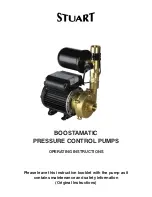
9
Original instructions
> English
Self-priming (refers MC97-impeller)
Pump is self-priming up to 4 m. Intake lines
must be air-tight to ensure self-priming.
Note: Pump will prime when impeller is dry
but suction lift up to 4 m is only obtainable
when impeller is lubricated with liquid being
pumped or Johnson Impeller Lubricant.
For permanent installations where suction
lift exceeds 4 m, a foot valve should be
used to assure priming on start up.
ALWAYS USE JOHNSON IMPELLER
LUBRICANT (glycerin) for impeller lubri-
cation. Never use grease or mineral oils.
Self-priming
(refers polyurethane impeller)
The pump is self-priming up to 1.5 metres
provided that the suction pipe is absolutely
airtight. Note! The pump is self-priming
when the impeller is dry, but to obtain
suction heads up to 1.5 metres the impeller
must be lubricated with the liquid to be
pumped or Johnson Impeller Lubricant. For
a permanent installation where the suction
head exceeds 1.5 metres a foot valve
should be fitted to ensure the pump can
provide suction immediately after starting.
ALWAYS USE JOHNSON IMPELLER
LUBRICANT (glycerin) for lubricating the
impeller. Never use grease or mineral oils.
Continuous duty
For continuous duty 0,6 bar (60 kPa, 8,5
psi) maximum head is permissible. Max
ambient temp is +60°C.
Dry running
Do not run dry for more than 30 seconds.
Lack of liquid will burn the impeller and
damage the seals.
Caution. Explosion Hazard.
Do not pump gasoline, solvents, thinners
or other flammable liquids.
Do not handle highly concentrated or
organic acids.
Caution. Explosion Hazard.
Never operate a motor which in any way
has been manipulated and lost it’s full
enclosure.
Temperature
Max ambient temperature: +60°C.
The life of the impeller depends on the
temperature of liquid being pumped. Tem-
peratures b5°C and +55°C give
normal life. Higher or lower temperature
will reduce the life.
Caution.
The normal working temperature of the
motor may reach approx. +80°C (surface
temperature) which may burn your skin.
Freezing weather
Drain unit by loosening the end cover.
Glycol based anti-freezes can be used but
do not use petroleum based anti-freeze
compounds.
Waste handling/material recycling
At the product’s end of life please dispose
of the product according to applicable law.
Where applicable please disassemble the
product and recycle the parts material.
Service instructions
(see page27-28)
Disassembly
1. Back off the endcover screws (7), re-
move the endcover (5) and O-ring (6).
2. Pull out the impeller (3) using a slip
joint plier.
3. Back off and remove the nuts (8)
and washers (9) holding the body.
Separate the body from the motor.
4. Remove the lip seal (4).
5. Do not disassemble the motor.










































